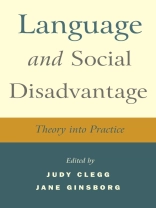Language and Social Disadvantage critically analyses and reviews the development of language in direct relation to social disadvantage in the early years and beyond. Definitions and descriptions of social disadvantage are addressed and wider aspects discussed. Theory and practice in relation to language development and social disadvantage are explored.
The book is divided into two sections: the first addresses the theoretical associations and relationships between social disadvantage and language, where cognition, literacy, behaviour, learning, socio-emotional development, intervention and outcomes are considered in depth. The second section applies the theory to practice, where real-life intervention studies in nurseries, schools and other contexts are reported. Research and practice based in the UK is a focus of all the chapters and research reports.
A genuinely interdisciplinary and collaborative approach is taken using perspectives from speech and language therapy, psychology and education. The book is ideal for professionals and students interested in the study of language development and intervention in the context of social disadvantage.
İçerik tablosu
List of contributors.
Introduction.
PART I.
Chapter 1 Language and social disadvantage: the effects of socio-economic status on children’s language acquisition and use (Jane Ginsborg).
Chapter 2 The interplay between language and cognition in typical and atypical development (Nicola Botting).
Chapter 3 Literacy and numeracy (Ivy Doherty and Jenny Landells).
Chapter 4 Childhood speech and language difficulties and later life chances (Judy Clegg).
Chapter 5 Language and the development of social and emotional understanding (Marion Farmer).
Chapter 6 Language, behaviour and social disadvantage (Helen Stringer and Judy Clegg).
Chapter 7 Language and communication in young people with learning difficulties: stories of social disadvantage (Monica Bray).
Chapter 8 The effects of intervention on the communication skills of socially disadvantaged children (James Law and Francis Harris).
PART II: Research reports.
Chapter 9 Interventions to promote language development in socially disadvantaged children – the devil may be in the detail (James Law).
9.1 Participation in Sure Start: lessons from language screening (Caroline Pickstone).
9.2 The ‘Teaching Children Talking’ project (Linda Hobbs).
9.3 The Talking Table (Marion Farmer and Fleur Griffiths).
9.4 Implementing effective oral language interventions in preschool settings: no simple solutions (Julie E. Dockrell, Morag Stuart and Diane King).
9.5 Working and learning together: an evaluation of a collaborative approach to intervention with student speech and language therapists and nursery staff (Jenny Leyden and Marcin Szczerbinkski).
9.6 Facilitating narrative and social skills in secondary school students with language and behaviour difficulties (Helen Stringer).
9.7 Enhancing language and communication in language impaired secondary school-aged children (Victoria Joffe).
Afterword (Ann Locke).
Index.
Yazar hakkında
Judy Clegg is a member of the Royal College of Speech and Language Therapists and is Lecturer, Human Communication Sciences, University of Sheffield, UK.
Jane Ginsborg is a Chartered Psychologist and is Research Fellow, the Royal Northern College of Music, Manchester, UK.












